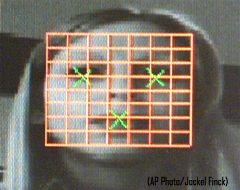By Tom Puller-Strecker
The Dominion Post
L.E. agencies fine-tune face ID
Question: Can a department legally use mug shots or a “Mug Book” for identification purposes?
WELLINGTON, NEW ZEALAND — The police have bought software that will let them automatically match faces caught on CCTV cameras against photographs of convicted criminals.
 |
Applications manager Ian Smith says the “normal rules surrounding gathering of evidence of a crime” will decide when the technology will be used.
The face-matching software will only work if cameras capture images that are of sufficient quality and from the right angle to match against photographs in its database, he says.
Police hold about 800,000 images of arrested people. All photographs taken after 1992 are stored electronically. Images are deleted if suspects are acquitted, but otherwise stay on the database indefinitely.
Mr Smith says Police do not know how many CCTV cameras it can access. But the use of security cameras has mushroomed worldwide thanks to low cost digital and wireless technologies.
Police signalled last year that they might build their own wireless broadband network and use remote video surveillance equipment to conduct “covert operations” within five to 10 years.
The proposal, contained in a submission to the Economic Development Ministry on radio spectrum management, raised the prospect that wireless video cameras that could easily be moved from place to place might be used to gather evidence against suspects.
Police have recommended that a new Police Bill that is currently being drafted should give them the authority to fingerprint drivers or people they stop in the street, using handheld computers.
Prints would be used to check people were not known offenders lying about their identities and could in future be matched against finger prints taken from unsolved crime scenes, according to a consultation document.
Handheld computers that checked people’s finger prints were tested on volunteers during a six- month trial in Porirua this year. The consultation document says it is important that there are “no legislative barriers” to the use of the technology.
Police have set up a Wiki that lets people put forward their own ideas for what should be included in the Police Bill. It is online at http://wiki.policeact.govt.nz.
Deputy commissioner Lyn Provost said last year that Police had got the go-ahead to invest more money in innovative technology after the successful development of its National Intelligence Application convinced the Government it had put the Incis computing debacle behind it.
Computer terminals and GPS transceivers are being fitted to police cars that let police access information about vehicles and suspects without having to radio their details to communication centres.
The face-matching technology is a spin off of a $600,000 contract that Police signed with United States technology firm Dataworks Plus to replace its existing 10 year-old image management system.
Dataworks’ software will also let Police quickly create photographic line-ups for witness to identify suspects. This previously had to be done manually and was a time- consuming process, Mr Smith says.
Facial recognition technology could be used to select images of faces for line-ups that had either similar or different characteristics to those of the suspect. Mr Smith says the issue of whether selection criteria might have implications for the reliability of identification parades is a “subjective” one.
But he says the methods used by Police to create photo line-ups will continue to follow the requirements of the Evidence Act and “tried and tested international standards”.
Copyright 2007 Wellington Newspapers Limited
All Rights Reserved

